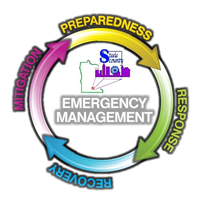Chemical agents are poisonous vapors, aerosols, liquids, and solids that have toxic effects on people, animals, or plants. Some chemical agents may be odorless and tasteless. They can have an immediate effect (a few seconds to a few minutes) or a delayed effect (2 to 48 hours). Signs of a chemical release include people having difficulty breathing; experiencing eye irritation; losing coordination; becoming nauseated; or having a burning sensation in the nose, throat, and lungs. Also, the presence of many dead insects or birds may indicate a chemical agent release.
To prepare for a chemical release, check your disaster supplies kit to make sure it includes:
- A roll of duct tape and scissors.
- Plastic for doors, windows, and vents for the room in which you will shelter in place. To save critical time during an emergency, pre-measure and cut the plastic sheeting for each opening.
- Choose an internal room to shelter, preferably one without windows and on the highest level.
If you are caught in or near a contaminated area, you should:
- Move away immediately in a direction upwind of the source.
- Find shelter as quickly as possible.
During a chemical release you should:
- Remain in your home or office building, if you are instructed to do so.
- Close doors and windows and turn off all ventilation, including furnaces, air conditioners, vents, and fans.
- Seek shelter in an internal room and take your disaster supplies kit.
- Seal the room with duct tape and plastic sheeting.
- Listen to your radio for instructions from authorities.
- Do not leave the safety of a shelter to go outdoors to help others until authorities announce it is safe to do so.
Decontamination is needed within minutes of exposure to minimize health consequences. A person affected by a chemical agent requires immediate medical attention from a professional. If medical help is not immediately available, decontaminate yourself and assist in decontaminating others. Decontamination guidelines are as follows:
- Use extreme caution when helping others who have been exposed to chemical agents.
- Remove all clothing and other items in contact with the body. Contaminated clothing normally removed over the head should be cut off to avoid contact with the eyes, nose, and mouth. Put contaminated clothing and items into a plastic bag and seal it.
- Decontaminate hands using soap and water.
- Remove eyeglasses or contact lenses. Put glasses in a pan of household bleach to decontaminate them, and then rinse and dry.
- Flush eyes with water.
- Gently wash face and hair with soap and water before thoroughly rinsing with water.
- Decontaminate other body areas likely to have been contaminated. Blot (do not swab or scrape) with a cloth soaked in soapy water and rinse with clear water.
- Change into uncontaminated clothes. Clothing stored in drawers or closets is likely to be uncontaminated.
- Proceed to a medical facility for screening and professional treatment when safe to do so.
A material safety data sheet (MSDS) is a form containing data regarding the properties of a particular substance. It is intended to provide workers and emergency personnel with procedures for handling or working with that substance in a safe manner. A MSDS includes information such as physical data (melting point, boiling point, flash point, etc.), toxicity, health effects, first aid, reactivity, storage, disposal, protective equipment, and spill handling procedures. The exact format of an MSDS can vary from source to source. generally, an MSDS is available directly from the manufacturer or distributor. An alternative is http://www.msdssearch.com.
Additional information on chemical hazards is available at:
Updated 10-Feb-2020
